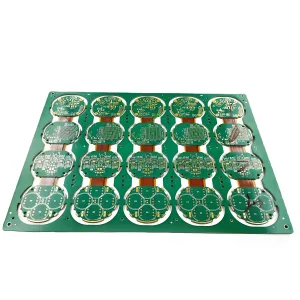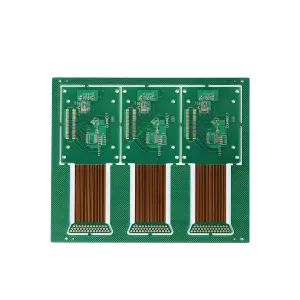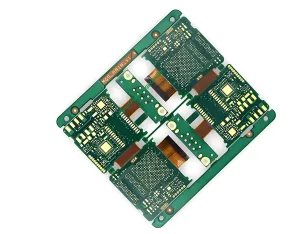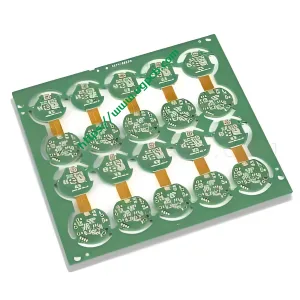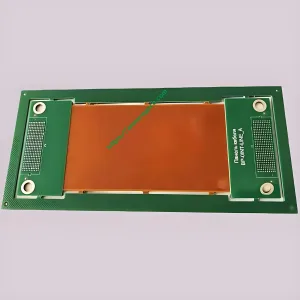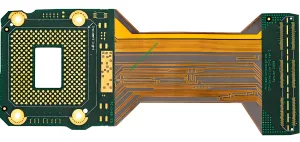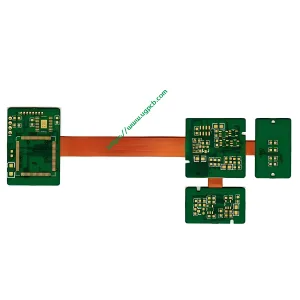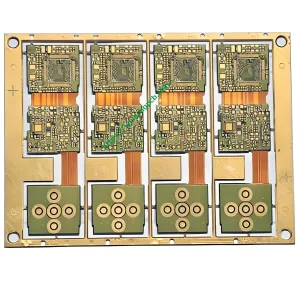FPC is also called flexible PCB or flexible printed circuit. FPC is made of polyimide (PI) or polyethylene terephthalate (PET) flexible PCB raw material that can be folded and bent. FPC is a flexible circuit board with high circuit density, léger, thin thickness, and good bending performance.
FPC is a method to meet the miniaturization and mobility requirements of electronic products. Flexible PCB board can be bent, wound, and folded freely, can withstand millions of dynamic bending without damaging the conductor, can be arranged arbitrarily according to the spatial layout requirements, and can move and expand freely in three-dimensional space, so as to achieve the integration of PCB assembly and conductor connection. FPC prototype also has the advantages of good heat dissipation, weldability, easy assembly, and low comprehensive cost. Donc, flexible substrate has been widely used in flexible circuit board led strip, aérospatial, militaire, mobile communication, laptop, computer peripherals, PDA, appareils photo numériques, and other fields or products. What is FPC? Do you know?
What is the difference between PCB vs FPC?
1. PCB is made by printing, so it is called a printed circuit board. FPC is also made by printing, so FPC flexible circuit board is also a PCB printed circuit board. Printed circuit boards include rigid PCB and flexible substrate. But we are used to referring to rigid PCB boards as PCB or PCB, The flexible PCB board is called FPC or FPCB.
2. Flexible PCB and rigid PCB space utilization is different. For PCB rigid circuit boards, unless the lines are made in three-dimensional form by film glue, the circuit board is flat in general. Donc, the design of electronic products should make full use of the three-dimensional space, and FPC flexible circuit board is a good solution. The common spatial extension scheme for PCB rigid circuit boards is to use slots plus interface cards. FPC flexible circuit boards can make similar structures as long as they are designed by means of transfer, and have more flexibility in directional design.
3. Flexible circuit pcb and rigid PCB circuit have different characteristics.FPC generally uses PI or PET as the base flexible substrate material and can bend or flex freely. PWB is generally made of FR4, ceramics, Téflon, and metal, which cannot be bent or flexed.
4. Flexible circuit PCB and rigid circuit PCB are used for different purposes. FPC flexible board is used on links that require repeated bending and some widgets. PCB rigid board is often used in places where bending is not required and where the hardness is comparatively high.
FPC vs PCB
Seven flexible substrate types
1. Single-side flexible PCB board is composed of “single-side circuit + film protecteur”. Single side flexible plate has good folding resistance.
2. The double-sided flexible PCB board is composed of “film protecteur + double-sided circuit + film protecteur”. The double-sided flexible board has copper foil on both sides of the double-sided board substrate, and the upper and lower layers are connected through PTH holes, so its flexibility is worse than that of the single panel.
3. Single plus single composite FPC board is composed of “film protecteur + single sideline + pure glue + single sideline + film protecteur”. It is to stick two single-sided copper foils together with pure glue and then conduct the two layers through PTH holes, and the pure glue in the bending area shall be excavated.
4. The embossed FPC board is composed of “pure copper foil + upper and lower protective films”. The thicker pure copper foil is pressed on the PI, and the hanging finger structure is formed in some areas. It is mostly used in the crimping of liquid crystal display (TFT) and can provide the plug-in function of dense welding.
5. Flexible multilayer PCB, flexible multilayer PCB is made of “multiple single-sided CCLS (or double-sided boards) + pure glue + film protecteur (CVL)”. The wires of each layer are connected through PTH holes. Due to too many layers, its flexibility is poor (the flexibility of the design area of pure glue opening is good)
6. The Flex-Rigid PCB is welded or pressed by “single-sided or double-sided FPC substrate + multi-layer rigid PCB substrate “. The lines on the Flex-Rigid PCB board are connected through PTH holes. The Flex-Rigid PCB board can realize three-dimensional assembly under different assembly conditions, has the characteristics of light, thin and short, and can reduce the assembly size, qualité, and wiring errors of electronic products.
7. Flexible PCB antenna is equivalent to pulling out the antenna line on the PCB and using other external metal as the antenna. It is usually used in medium and low-end mobile phones and intelligent hardware products with complex frequency bands. This flexible circuit antenna is applicable to almost all small electronic products and can be used as a complex antenna in more than 10 frequency bands such as 4G. It has good performance and low cost.
How to make flexible PCB?
2 layer flexible PCB manufacturing process
Coupe – forage – PTH – electroplating – pretreatment – paste dry film – alignment – exposition – développement – graphic electroplating – film removal – pretreatment – paste dry film – alignment exposure – développement – gravure – film removal – traitement de surface – paste covering film – pressage – curing – nickel deposition – character printing – coupe – electrical measurement – perforation – inspection finale – conditionnement – expédition
1 layer flexible PCB manufacturing process
Coupe – forage – sticking dry film – alignment – exposition – développement – gravure – stripping – traitement de surface – sticking covering film – pressage – curing – traitement de surface – nickel gold deposition – character printing – shearing – electrical measurement – perforation – inspection finale – conditionnement – expédition
How to solder FPC to PCB and how to clear flexible PCB?
The soldering flexible PCB needs to use an FPC connector to connect with PCB, so the Rigid-Flex PCB appears. The Rigid-Flex PCB can save the cost of connector solder FPC to PCB and FPC connector. It also has better space utilization and more stable performance. Cependant, the cost of Rigid-Flex PCB is much higher than that of PCB flexible.
Ion cleaning flexible PCB machine can solve the problem of poor hydrophilicity of FPC and poor adhesion of copper plating. The poor hydrophilicity of PI, a flexible PCB material, is the fundamental reason affecting the reliability of copper plating. The surface treatment of PI substrate by plasma cleaning machine can effectively improve the hydrophilicity of PI material, The water contact angle meter is used to measure the PI material before and after plasma surface treatment. The water contact angle can be reduced from more than 450 to less than 50. If magnetron sputtering coating is carried out at this time, the bonding force of copper film can meet the expected requirements.
Sometimes, for the soldering FPC, because it is too soft, we need to design a reinforcement for it. The FPC reinforcement is usually made by Altium flexible PCB. When we need to solder components to FPC, design flexible substrate connects by flexible aluminum PCB to PCB circuit board. It can make the FPC circuit board production port have better hardness. This makes it assembly more convenient.
Features of FPC
FPCS have flexibility and reliability. Actuellement, there are four types of FPC flexible PCB boards: single-sided, double face, multicouche, and Flex-Rigid PCB.
1. Single-sided FPC is the least costly when they do not require high electrical performance. When wiring single-sided PCB circuit boards, one-sided flexible boards should be selected. It has a chemical etched conductive pattern and a calendered copper foil as the conductive pattern layer on the flexible insulating base material. Insulation materials can be polyimide, polyethylene terephthalate, acrylamide fiber ester, and polyvinyl chloride.
2. The double-sided FPC is a conductive graphic made by etching one layer on each side of the insulation base membrane. Metalized holes connect graphics on both sides of the insulating material to form conductive paths to meet flexibility design and useful functions. Covering protects single and double-sided wires and indicates where components are placed.
3. FPC Multilayer circuit board is layers of one-sided or two-sided flexible circuits with three or more layers, and metalized holes are formed by drilling Ls and electroplating to form conductive paths between layers. This eliminates the need for complex welding processes. Multilayer circuits have huge functional differences in higher reliability, better thermal conductivity, and more convenient assembly performance. The interaction of assembly size, number of layers, and flexibility should be taken into account when designing the layout.
4. Traditional rigid and flexible circuit boards are made up of Rigid and flexible substrates with selective strata pressed together. The structure is compact and conducted with metalized Ls. Flex-Rigid PCB is a good choice if both the front and back sides of a printed circuit board have components. Cependant, if all the components are on one side, it would be cheaper to use a double-sided flexible plate with a layer of FR4 reinforcement material on its back.
5. The FPC flexible circuit with a hybrid structure is a multilayer PCB circuit board, and the conductive layer is composed of different metals. An 8-layer panel uses FR-4 as the inner medium and polyimide as the outer medium. Leads are extended from three different directions of the motherboard, each made of different metals. Langtang alloy, cuivre, and gold are used as separate leads. This hybrid structure is mostly used in low temperatures where the relationship between electrical signal conversion and heat conversion and the electrical performance is more demanding and is the only feasible solution.
The convenience and total cost of the internal design can be evaluated to achieve the best performance-price ratio.
The economy of FPC
If the FPC circuit design is relatively simple, the total size is small, and the space is suitable, the traditional internal connection is mostly much cheaper. Flexible circuits are a good design option for complex circuits, processing many signals, or having special electrical or mechanical properties. Flexible assembly is most economical when the size and performance of the application exceed the capabilities of Rigid circuits. A 12mil bonding pad with 5MIL holes and a 3mil line and spacing flexible circuit can be made on a single film. Donc, it is more reliable to mount the chip directly on the film. Because it does not contain flame retardants that may be sources of ionic drilling dirt. These films may be protective and cured at higher temperatures to obtain higher glass transition temperatures. The cost savings of flexible materials over Rigid materials are due to the exemption of plug-ins.
The high cost of raw materials is the main reason for the high price of flexible circuits. The prices of raw materials vary greatly, and the cost of raw materials used for the least-cost polyester flexible circuit is 1.5 times that of raw materials used for the Rigid circuit. High-performance polyimide flexible circuits are up to four times or higher. En même temps, the flexibility of materials makes it difficult to automate processing during the manufacturing process, which results in a decrease in output. Defects occur during the final assembly process, including stripping off flexible attachments and line breakage. This is more likely to occur when the design is not suitable for the application. Under high stress caused by bending or shaping, reinforcement or reinforcement materials are often required. Despite its high cost of raw materials and cumbersome manufacturing, the foldable, bendable, and multi-layer splicing functions reduce the overall component size, reduce the material used, and reduce the overall assembly cost.
Flexible PCB circuit board industry is in the process of small-scale but rapid development. The polymer thick film process is an efficient and low-cost production process. This process selectively prints conductive polymer ink on inexpensive flexible substrates. The representative flexible base material is PET. Polymer thick-film conductors include silk-printed metal or carbon powder fillers. The polymer thick-film process itself is clean and uses lead-free SMT adhesives without etching. The polymer thick-film circuit is one-tenth of the price of the copper polyimide thin-film circuit because of its additive process and low cost of the base material. It is 1/2-1/3 of the price of a Rigid printed circuit board. The polymer thick film method is especially suitable for the control panel of the device. On mobile phones and other portable products, the polymer thick-film method is suitable for converting components, commutateurs, and lighting devices on the printed circuit motherboard into polymer thick-film circuits. It saves both costs and energy consumption.
En général, flexible PCB boards are indeed more expensive and costly than Rigid circuits. Flexible PCB boards are manufactured with the fact that many parameters are out of tolerance. The difficulty in making a flexible circuit is the flexibility of the material.
FPC (Flexible Printed Circuit Board) is widely used in several industries due to its excellent flexibility and thin and light characteristics. Its main application areas include electronics, électronique automobile, medical devices and industrial controls.
1. Electronics
FPC boards are used in a wide range of electronic products, including cell phones, comprimés, and smart wearable devices. Their design allows for a high degree of integration and can support miniaturized and high-density circuit connections, thus enhancing the performance and portability of electronic products.
2. Électronique automobile
In the automotive field, FPC boards are widely used for in-car navigation systems, entertainment systems, and communication devices. They provide flexible connectivity solutions in restricted spaces to ensure the performance and stability of automotive electronic systems.
3. Équipement médical
FPC circuit boards are increasingly used in medical equipment, commonly found in sign monitoring equipment, therapeutic instruments and medical imaging equipment. They are able to maintain reliability in high temperature and high humidity environments and comply with medical safety standards.
4. Industrial Controls
In the field of industrial control, FPC circuit boards are used in systems such as automation equipment and robots to provide high-density wiring and reliable connections. These boards fulfill the need for high performance and stability in modern industrial equipment.
5. Aérospatial
FPC boards have also found applications in aerospace and aviation, where they are selected for their thinness and high vibration resistance in critical equipment to reduce overall weight and improve vehicle performance.
Cost of FPC
The price of FPC assemblies is dropping, becoming close to traditional Rigid circuits. The main reason is the introduction of updated FPC materials, the improvement of the production process, and the change of structure. Now the structure makes the product more heat stable and few materials do not match. Some newer materials can produce more sophisticated lines because the copper layer is thinner, making the components lighter and more suitable for small spaces. Dans le passé, the copper foil was adhered to adhesive-coated media by the roll-pressing process. Aujourd'hui, copper foil can be produced directly on the media without using adhesive. These techniques result in copper layers that are several microns thick, and fine lines that are 3m.1 or even narrower in width. Flexible circuits with some adhesives removed have flame retardant properties. This will speed up the uL certification process and further reduce costs. FPC flexible circuit board solder masks and other surface coatings further reduce the cost of flexible assembly.
Future development of FPC
1. Thickness of FPC. The thickness of FPC is becoming more and more flexible and thin.
2. Folding resistance of FPC. It is an inherent characteristic of FPC that it can bend. The bending resistance of FPC exceeds millions of times.
3. FPC price. At this stage, the price of FPC is much higher than that of PCB, and the price of FPC will be cheaper in the future.
4. With the upgrading of the FPC process level, the minimum aperture and minimum line width/line distance meet higher requirements.
À l'avenir, plus petit, more complex, and more expensive flexible circuits for FPC assembly will require more innovative ways to assemble FPC and additional hybrid flexible circuits. The challenge for the flexible circuit industry is to leverage its technological advantages to keep up with computers, remote communications, consumer demand, and an active market. En outre, FPC flexible circuits will play an important role in lead-free operations.
There are many cheap flexible PCB manufacturers in China who quote flexible PCB board price. UGPCB is a professional flexible PCB company. We provide flexible PCB prototype and flexible PCB service and give you low cost flexible PCB. If you need to buy FPC flexible PCB, please contact UGPCB custom flexible PCB.
 LOGO UGPCB
LOGO UGPCB


